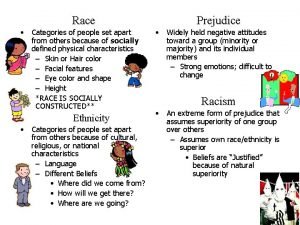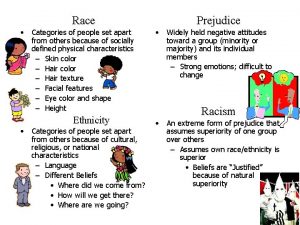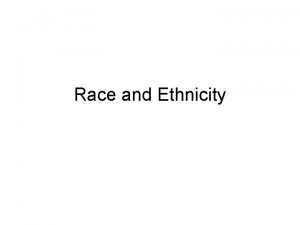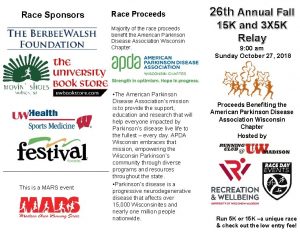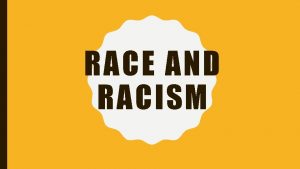Race Categories of people set apart from others




















- Slides: 20

Race • Categories of people set apart from others because of socially defined physical characteristics – Skin or Hair color – Facial features – Eye color and shape – Height *RACE IS SOCIALLY CONSTRUCTED** Ethnicity • Categories of people set apart from others because of cultural, religious, or national characteristics – Language – Different Beliefs • Where did we come from? • How will we get there? • Where are we going? Prejudice • Widely held negative attitudes toward a group (minority or majority) and its individual members – Strong emotions; difficult to change Racism • An extreme form of prejudice that assumes superiority of one group over others – Assumes own race/ethnicity is superior • Beliefs are “Justified” because of natural superiority

• • Discrimination Treating people differently based on ethnicity, race, religion, or culture – Involves ACTING upon prejudiced/racists thoughts • Avoiding social contact with members of minority groups • Denying positions of authority • Blocking access to more exclusive neighborhoods – EXTREMES • Hate Crimes – Attacks or killing minority members • Minority Groups A group of people with physical or cultural traits different from those of the dominant group in the society – Dominated by the majority • Unequal share of goods, services, and privileges • Presumed to be inferior Scapegoat A weak, convenient, and socially approved target ; often a minority – Present when people cannot pinpoint the source of their problems • Direct anger towards target – Targeted individual/group shoulder the blame and pay terrible penalties for “causing” society’s ills

Cultural Pluralism • Racial and ethnic groups cooperate while still retaining their distinctive identities and lifestyles – Reflects desires of minority groups to cooperate with others, yet preserve their distinctive cultural heritages • “Tossed Salad” Assimilation • A process by which minority groups lose their distinctive identities and conform to cultural patterns of the dominant group – Encouraged or required to adopt dominant culture • “Melting Pot” Segregation • Physical or social exclusion of minority groups from dominant group activities – De jure: Segregation by law • Jim Crow Laws – Separate waiting rooms for Blacks and Whites – De facto: Segregation by custom • Sitting at different lunch tables, separated by race

Racial and Ethnic Populations Note: This map is not geographically representative of population distribution. SOURCE: U. S. Bureau of the Census 2008 b. 65. 9% WHITE (NON-HISPANIC) 198, 420, 355 people 15. 1% HISPANIC OR LATINO 45, 432, 158 people 12. 1% AFRICAN AMERICAN 36, 397, 922 people 4. 3% ASIAN 13, 000, 306 people 1. 6% 0. 7% 0. 1% 0. 2% TWO OR MORE RACES AMERICAN INDIAN AND ALASKA NATIVE HAWAIIAN AND OTHER PACIFIC ISLANDER SOME OTHER RACE 2, 041, 269 people 413, 294 people 4, 794, 461 people Essentials Of Sociology, 3 rd Edition Copyright © 2011 W. W. Norton & Company 737, 938 people 4

Figure 10. 2 A High School Graduation Rates by Race and Ethnicity, 2008. Essentials Of Sociology, 3 rd Edition Copyright © 2011 W. W. Norton & Company

Figure 10. 2 B High School Graduation Rates by Race and Ethnicity, 2008. Essentials Of Sociology, 3 rd Edition Copyright © 2011 W. W. Norton & Company

Sociological Perspectives on Race

Sociological Distinctions of Sex & Gender • Sex – Biological – We are Male or Female – Ascribed status • Gender – Social, cultural, and psychological – Masculine or Feminine – Achieved status Portions © Copyright 2012 Alan S. Berger and other portions © 8

The Social Construction of Gender • Gender-Role Socialization • Boys must be masculine: – – – Active Aggressive Tough Daring Dominant • Girls must be feminine: – – Soft Emotional Sweet Submissive

“THE RULE OF FATHERS” A FORM OF SOCIAL ORGANIZATION IN WHICH MALES DOMINATE FEMALES • MATRIARCHY – SOCIAL DOMINANCE BY WOMEN • SEXISM – BELIEF THAT ONE SEX OR THE OTHER IS INNATELY INFERIOR OR SUPERIOR – UNTOLD LOSSES WHEN CONSIDERING HOW MUCH TALENT HAS BEEN LOCKED OUT • INEVITABILITY OF PATRIARCHY – IS BIOLOGY DESTINY? SHOULD WOMEN RULE?

IT STARTS IN THE FAMILY • SELECTIVE ABORTION – SOCIAL VALUE AND DEATH • IS IT A BOY OR GIRL? – COLOR-CODING GENDER • HANDLING OF CHILDREN – BE A GOOD “LITTLE MAN” • IT’S OK TO BE A TOM-BOY – WHY WOULDN’T A GIRL WANT TO BE A BOY? – BUT, WHAT IF A BOY ACTS TOO MUCH LIKE A GIRL?

Gender Stereotypes (Stereotype = oversimplified conceptions) • These stereotypes are NOT universal. They Vary – From society to society – From Culture to culture – Over time • Gender Role = set of expectations Based upon one’s gender in society Portions © Copyright 2012 Alan S. Berger and other portions © 12



How many insults are related to women/femininity?

Women: The Oppressed Majority • The Status of Women Worldwide – Women’s and men’s worlds differ in access to education and work opportunities • Women in the Workforce of the U. S. – Women’s participation in paid labor force in U. S. increased steadily throughout the 20 th century • Census bureau found 2 occupations out of 821 in which women typically earn about 1% more income than men


Women: The Oppressed Majority Figure 12 -1. Gender Inequality in Industrial Nations Source: Fuwa 2004: 757

FEMINISM IN AMERICA ITS MOST BASIC PRINCIPLES • IMPORTANCE OF CHANGE – IT IS CRITICAL • EXPANSION OF HUMAN CHOICE – NO RESTRICTIONS ON POTENTIAL • NO GENDER STRATIFICATION – EQUALITY UNDER THE LAW • ENDING SEXUAL VIOLENCE – DISTORTS RELATIONSHIPS • SEXUAL AUTONOMY – CONTROL OVER REPRODUCTION

Explaining Inequality by Gender Table 12 -2. Sociological Perspectives on Gender
 Set apart from others
Set apart from others What is the threat that curley's wife makes in crooks cabin
What is the threat that curley's wife makes in crooks cabin Data race vs race condition
Data race vs race condition Specific speed of turbine
Specific speed of turbine Dam spillway types
Dam spillway types Total set awareness set consideration set
Total set awareness set consideration set Training set validation set test set
Training set validation set test set Let us run with endurance the race that is set before us
Let us run with endurance the race that is set before us Purify my heart brian doerksen
Purify my heart brian doerksen What did dmitri mendeleev do that set him apart? *
What did dmitri mendeleev do that set him apart? * Crisp set vs fuzzy set
Crisp set vs fuzzy set Crisp set vs fuzzy set
Crisp set vs fuzzy set Bounded set vs centered set
Bounded set vs centered set Surjective vs injective
Surjective vs injective What is the overlap of data set 1 and data set 2?
What is the overlap of data set 1 and data set 2? Fuzzy logic
Fuzzy logic People killin people dying
People killin people dying Recovery community
Recovery community Justpeople
Justpeople Who do you think are “people media”?
Who do you think are “people media”? Wiener rh-hr terminology
Wiener rh-hr terminology
